towing Lexus GX460 2014 Using the air conditioning system and defogger / LEXUS 2014 GX460 (OM60K80U) Owner's Guide
[x] Cancel search | Manufacturer: LEXUS, Model Year: 2014, Model line: GX460, Model: Lexus GX460 2014Pages: 622, PDF Size: 8.61 MB
Page 454 of 622
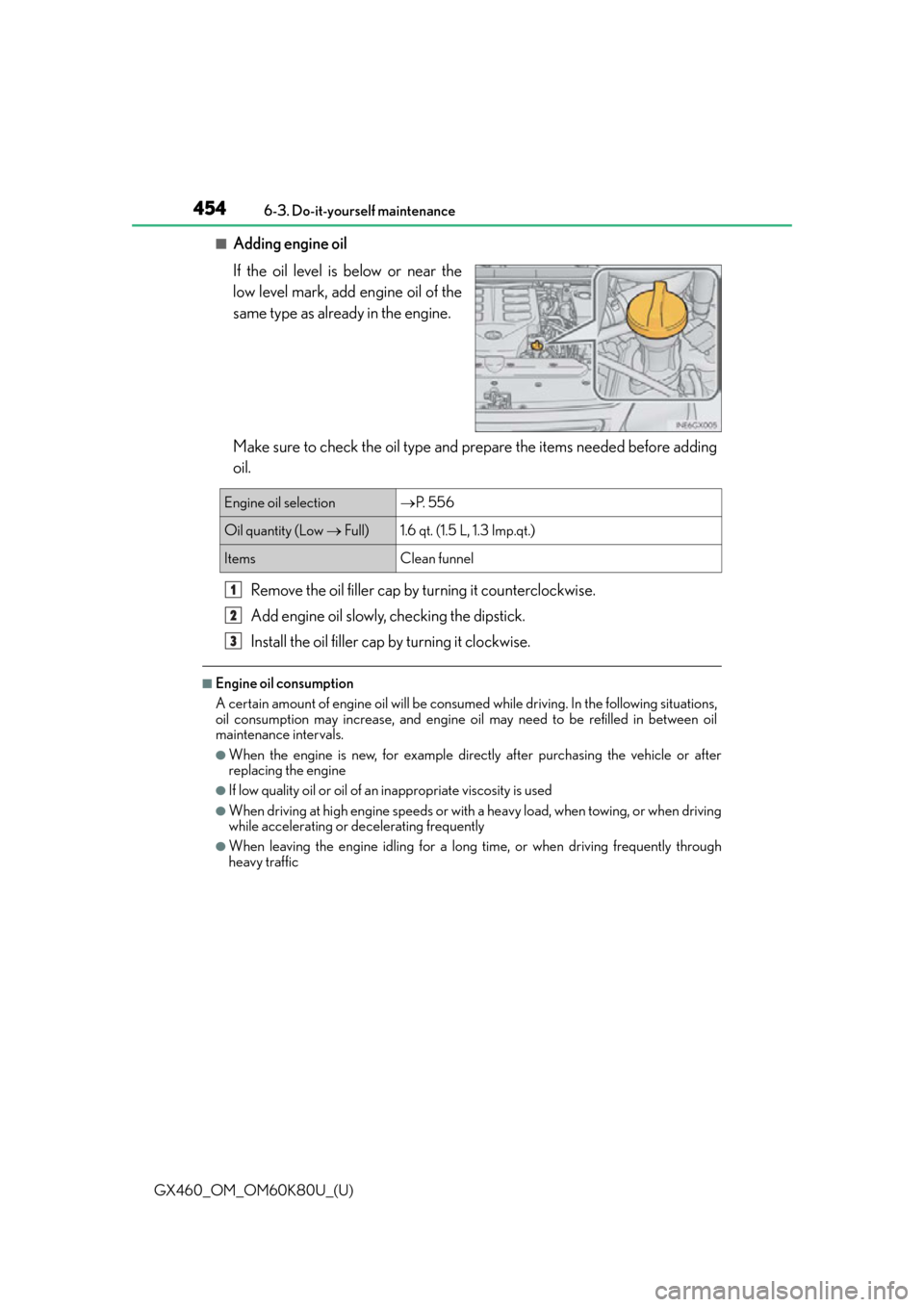
454
GX460_OM_OM60K80U_(U)6-3. Do-it-yourself maintenance
■Adding engine oil
If the oil level is below or near the
low level mark, add engine oil of the
same type as already in the engine.
Make sure to check the oil type and prepare the items needed before adding
oil.
Remove the oil filler cap by turning it counterclockwise.
Add engine oil slowly, checking the dipstick.
Install the oil filler cap by turning it clockwise.
■Engine oil consumption
A certain amount of engine oil will be consum ed while driving. In the following situations,
oil consumption may increase, and engine o il may need to be refilled in between oil
maintenance intervals.
●When the engine is new, for example directly after purchasing the vehicle or after
replacing the engine
●If low quality oil or oil of an inappropriate viscosity is used
●When driving at high engine speeds or with a heavy load, when towing, or when driving
while accelerating or de celerating frequently
●When leaving the engine idling for a long time, or when driving frequently through
heavy traffic
Engine oil selection P. 5 5 6
Oil quantity (Low Full)1.6 qt. (1.5 L, 1.3 Imp.qt.)
ItemsClean funnel
1
2
3
Page 500 of 622
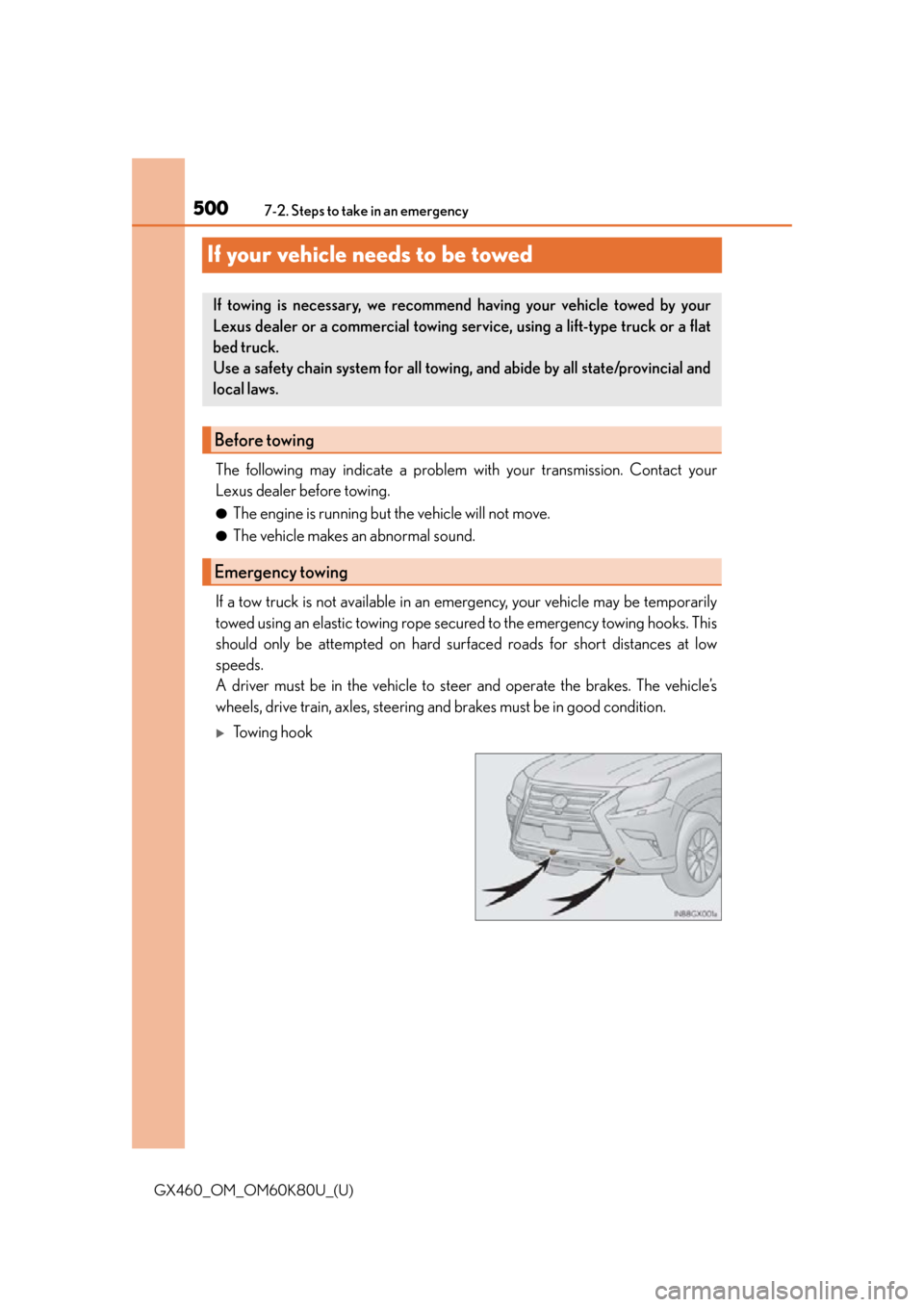
500
GX460_OM_OM60K80U_(U)7-2. Steps to take in an emergency
If your vehicle needs to be towed
The following may indicate a problem with your transmission. Contact your
Lexus dealer before towing.
●The engine is running but the vehicle will not move.
●The vehicle makes an abnormal sound.
If a tow truck is not available in an emergency, your vehicle may be temporarily
towed using an elastic towing rope secured to the emergency towing hooks. This
should only be attempted on hard su rfaced roads for short distances at low
speeds.
A driver must be in the vehicle to steer and operate the brakes. The vehicle’s
wheels, drive train, axles, steering an d brakes must be in good condition.
To w i n g h o o k
If towing is necessary, we recommend having your vehicle towed by your
Lexus dealer or a commercial towing service, using a lift-type truck or a flat
bed truck.
Use a safety chain system for all towing, and abide by all state/provincial and
local laws.
Before towing
Emergency towing
Page 501 of 622
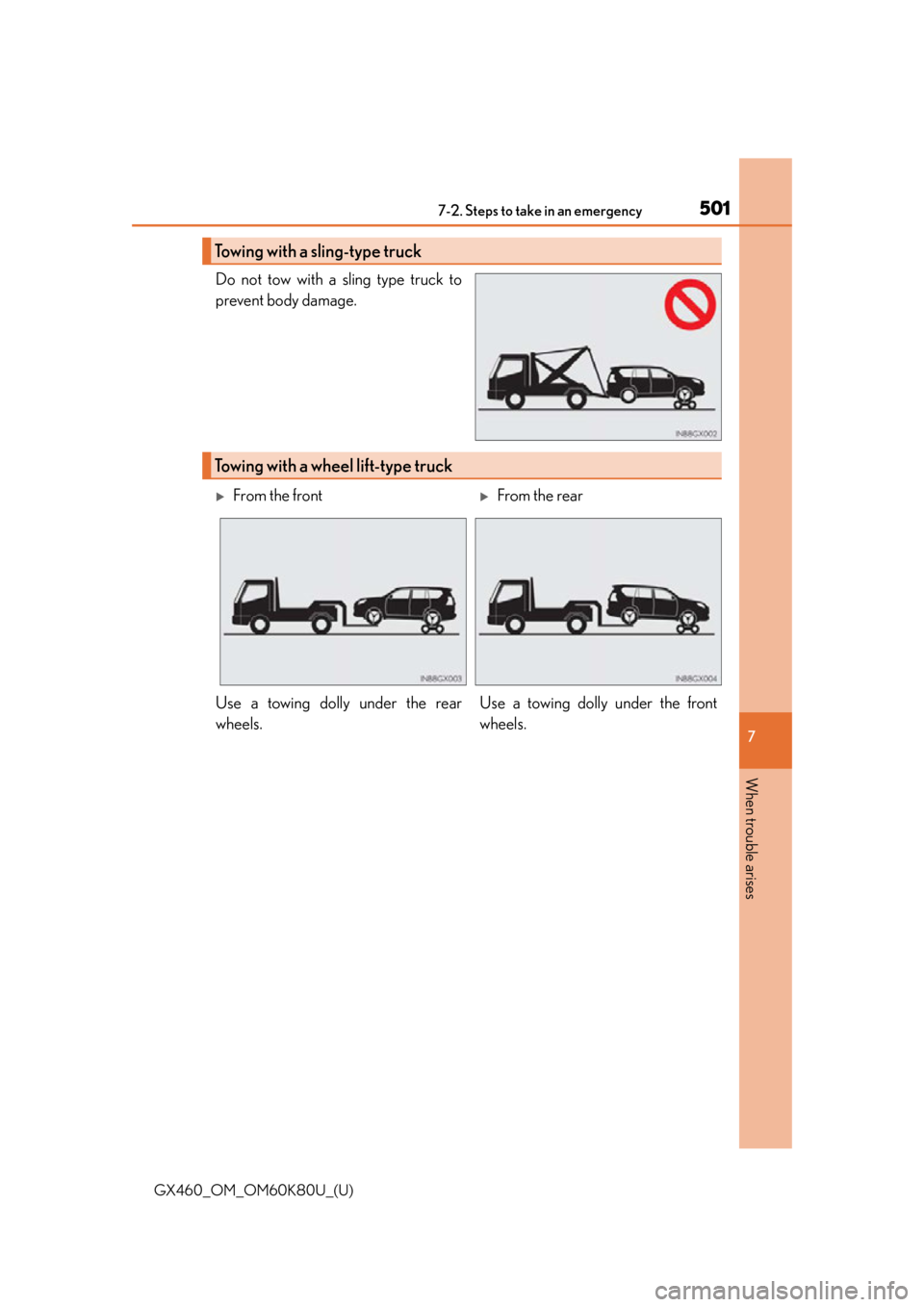
5017-2. Steps to take in an emergency
GX460_OM_OM60K80U_(U)
7
When trouble arises
Do not tow with a sling type truck to
prevent body damage.
Towing with a sling-type truck
Towing with a wheel lift-type truck
From the frontFrom the rear
Use a towing dolly under the rear
wheels. Use a towing dolly under the front
wheels.
Page 502 of 622
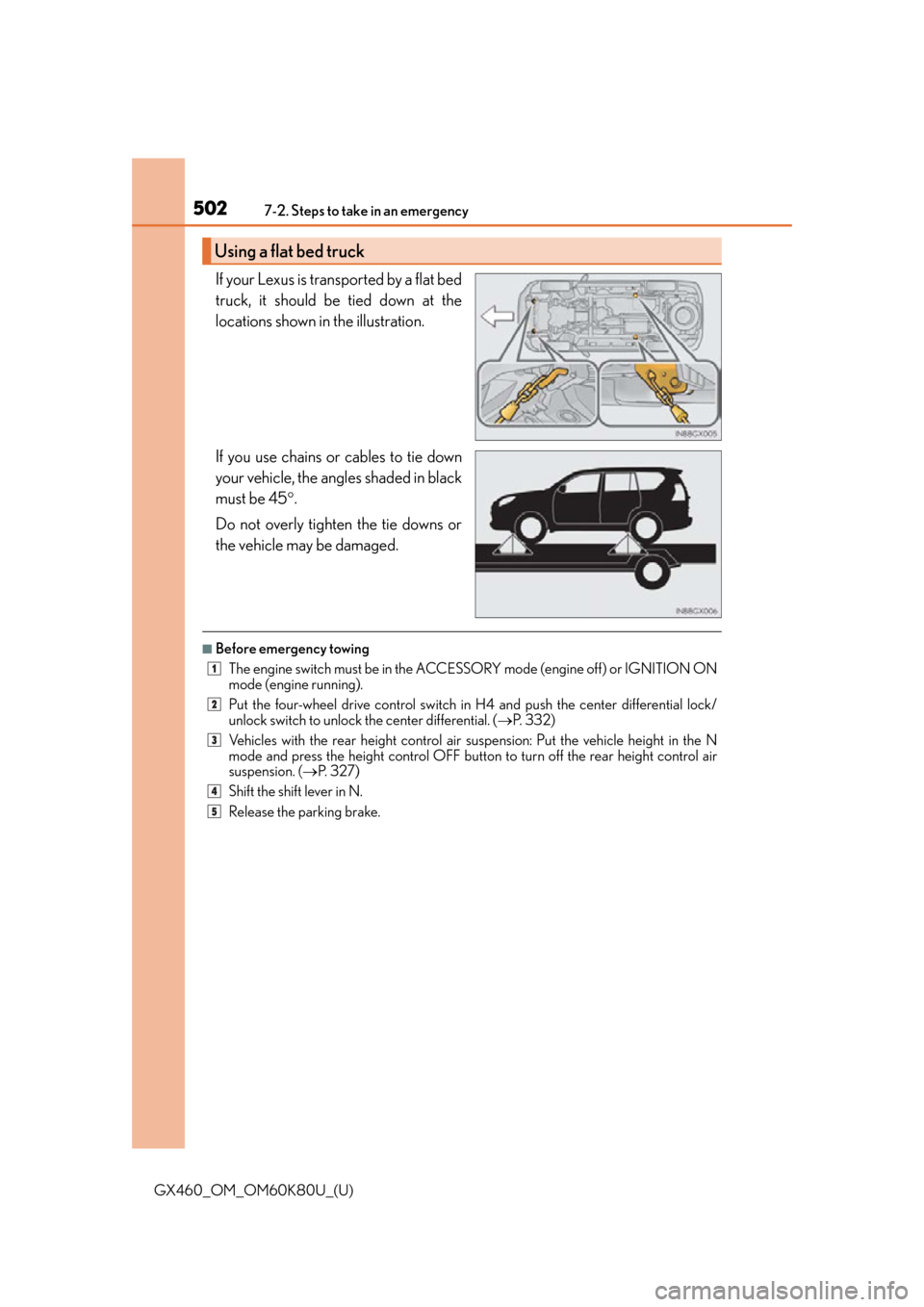
5027-2. Steps to take in an emergency
GX460_OM_OM60K80U_(U)
If your Lexus is transported by a flat bed
truck, it should be tied down at the
locations shown in the illustration.
If you use chains or cables to tie down
your vehicle, the angles shaded in black
must be 45.
Do not overly tighten the tie downs or
the vehicle may be damaged.
■Before emergency towing The engine switch must be in the ACCESSORY mode (engine off) or IGNITION ON
mode (engine running).
Put the four-wheel drive control switch in H4 and push the center differential lock/
unlock switch to unlock the center differential. ( P. 3 3 2 )
Vehicles with the rear height control air suspension: Put the vehicle height in the N
mode and press the height control OFF button to turn off the rear height control air
suspension. ( P. 3 2 7 )
Shift the shift lever in N.
Release the parking brake.
Using a flat bed truck
1
2
3
4
5
Page 503 of 622
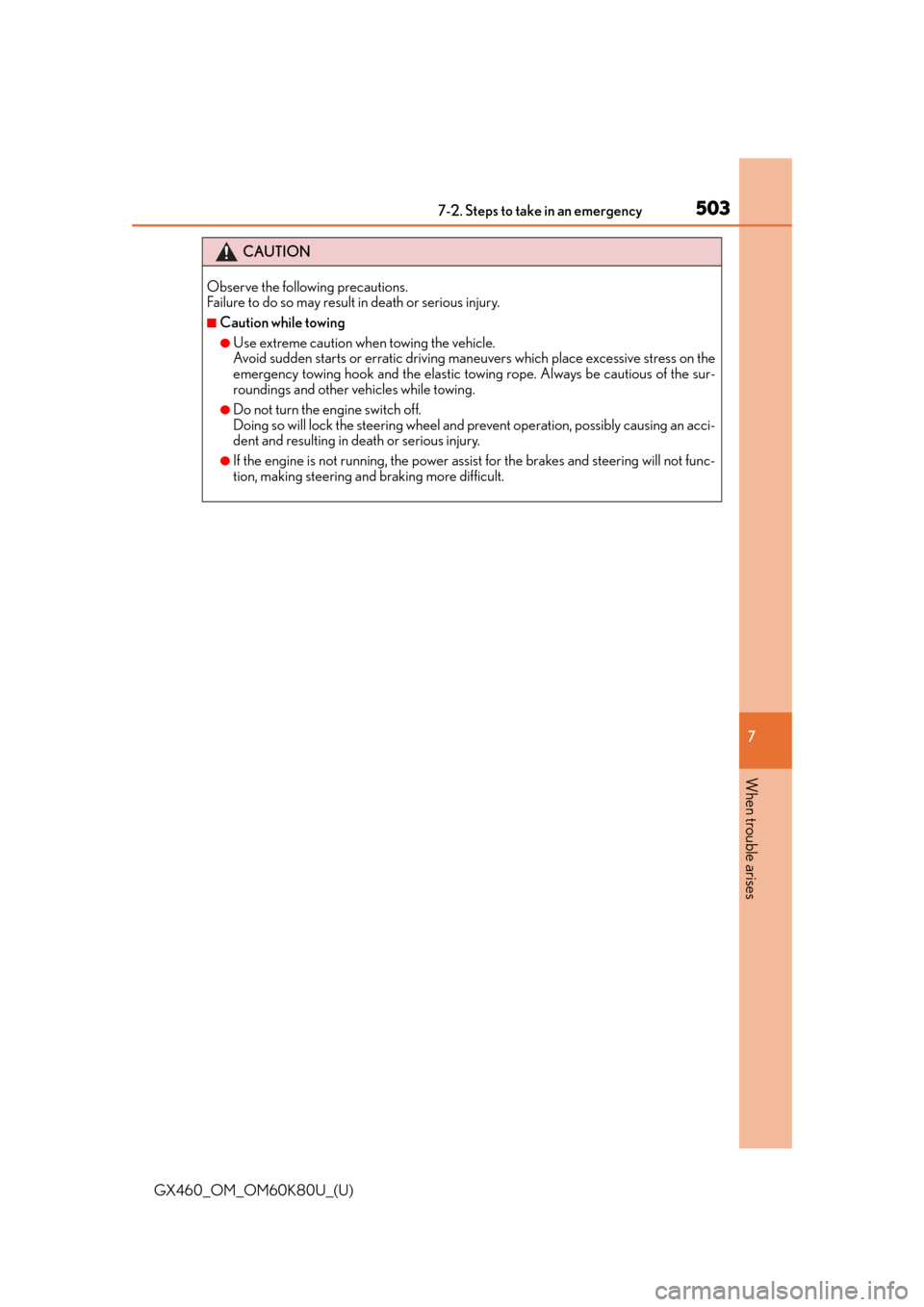
5037-2. Steps to take in an emergency
GX460_OM_OM60K80U_(U)
7
When trouble arises
CAUTION
Observe the following precautions.
Failure to do so may result in death or serious injury.
■Caution while towing
●Use extreme caution when towing the vehicle.
Avoid sudden starts or erratic driving mane uvers which place excessive stress on the
emergency towing hook and the elastic towing rope. Always be cautious of the sur-
roundings and other vehicles while towing.
●Do not turn the engine switch off.
Doing so will lock the steering wheel and pr event operation, possibly causing an acci-
dent and resulting in death or serious injury.
●If the engine is not running, the power assist for the brakes and steering will not func-
tion, making steering and braking more difficult.
Page 504 of 622
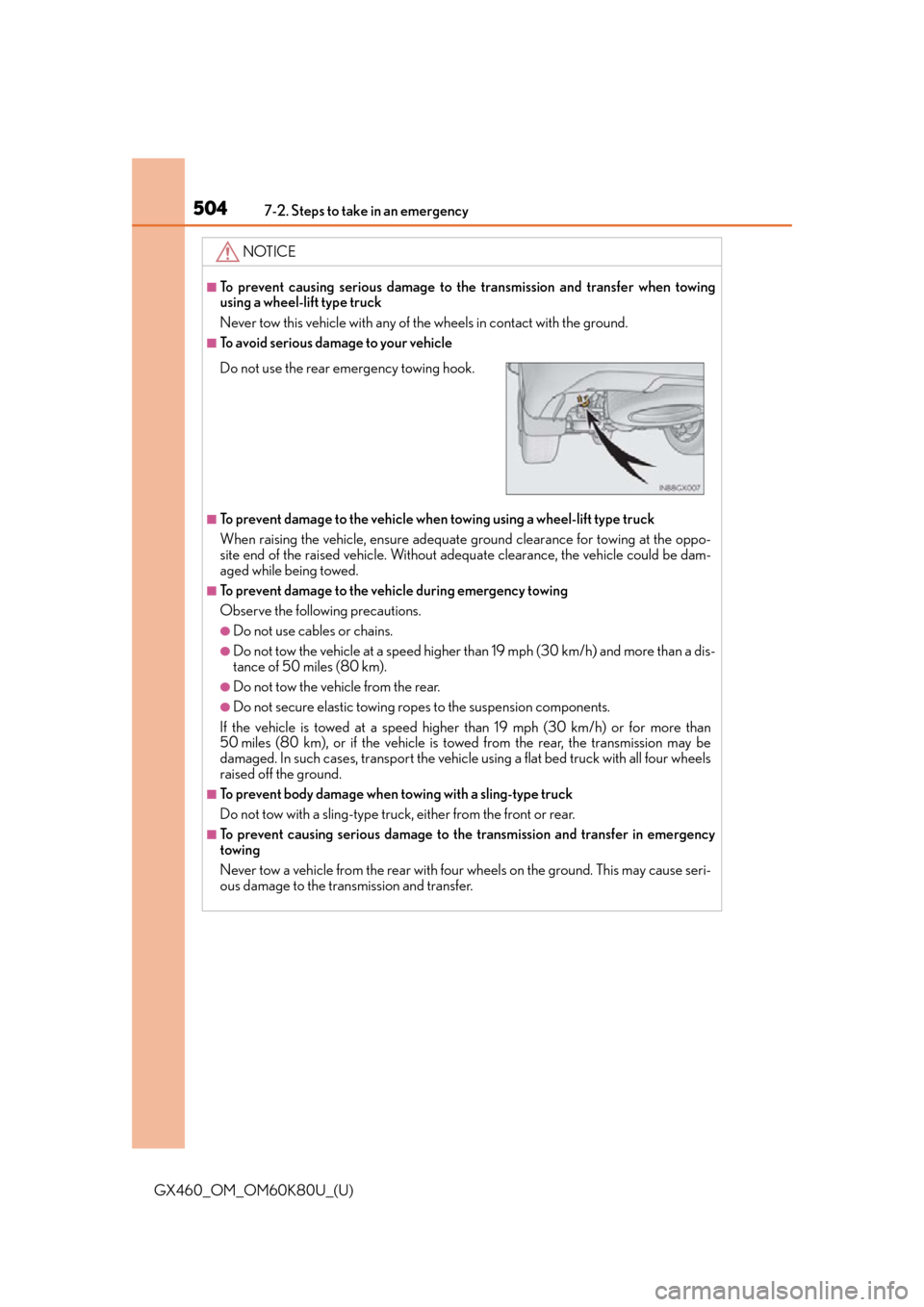
5047-2. Steps to take in an emergency
GX460_OM_OM60K80U_(U)
NOTICE
■To prevent causing serious damage to the transmission and transfer when towing
using a wheel-lift type truck
Never tow this vehicle with any of th e wheels in contact with the ground.
■To avoid serious damage to your vehicle
■To prevent damage to the vehicle when towing using a wheel-lift type truck
When raising the vehicle, ensure adequate ground clearance for towing at the oppo-
site end of the raised vehicle. Without adequate clearance, the vehicle could be dam-
aged while being towed.
■To prevent damage to the vehicle during emergency towing
Observe the following precautions.
●Do not use cables or chains.
●Do not tow the vehicle at a speed higher than 19 mph (30 km/h) and more than a dis-
tance of 50 miles (80 km).
●Do not tow the vehicle from the rear.
●Do not secure elastic towing ropes to the suspension components.
If the vehicle is towed at a speed higher than 19 mph (30 km/h) or for more than
50 miles (80 km), or if the vehicle is towed from the rear, the transmission may be
damaged. In such cases, transport the vehicle using a flat bed truck with all four wheels
raised off the ground.
■To prevent body damage when to wing with a sling-type truck
Do not tow with a sling-type truck, either from the front or rear.
■To prevent causing serious damage to the transmission and transfer in emergency
towing
Never tow a vehicle from the rear with four wheels on the ground. This may cause seri-
ous damage to the transmission and transfer.
Do not use the rear emergency towing hook.
Page 538 of 622
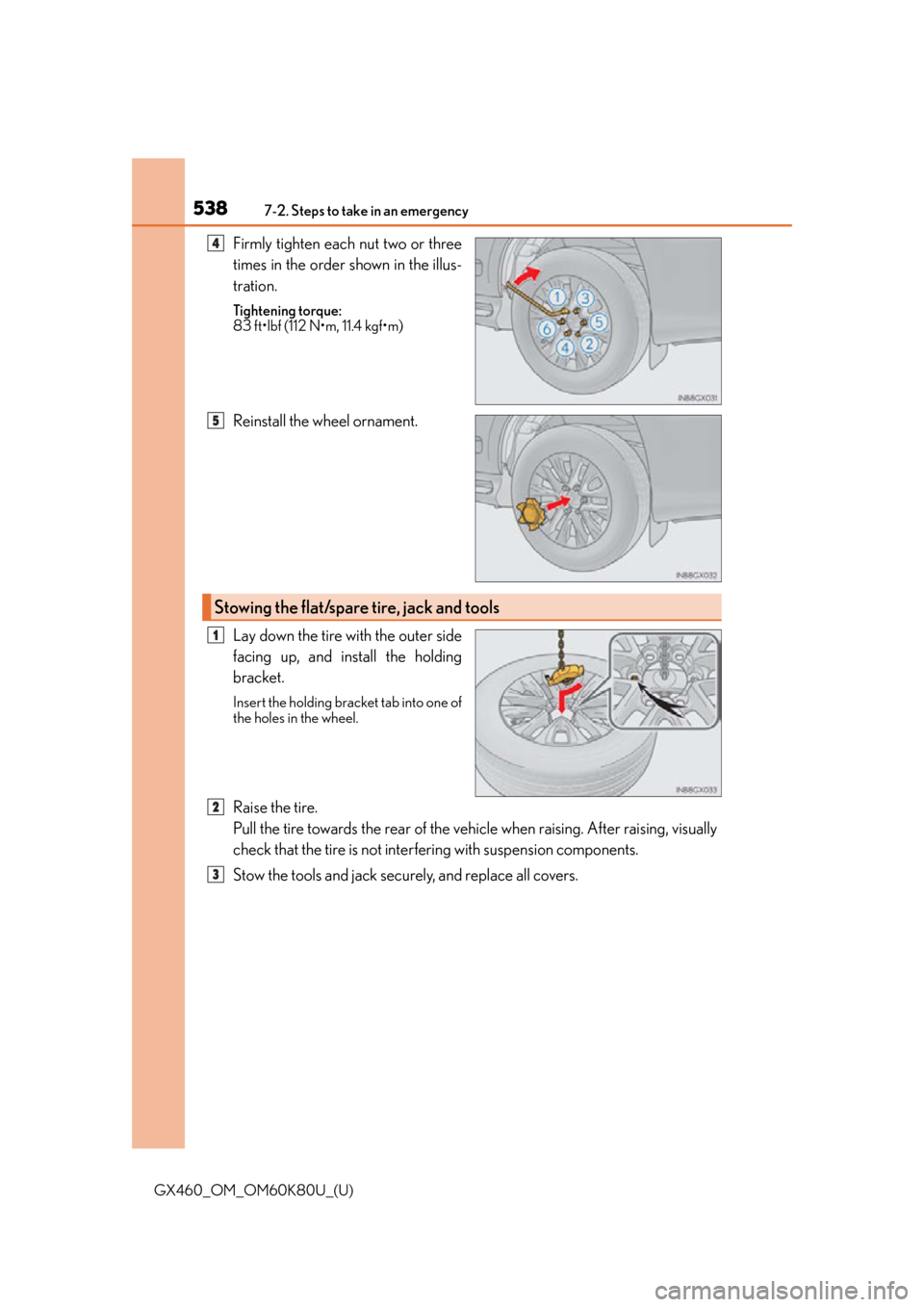
5387-2. Steps to take in an emergency
GX460_OM_OM60K80U_(U)
Firmly tighten each nut two or three
times in the order shown in the illus-
tration.
Tightening torque:
83 ft•lbf (112 N•m, 11.4 kgf•m)
Reinstall the wheel ornament.
Lay down the tire with the outer side
facing up, and install the holding
bracket.
Insert the holding bracket tab into one of
the holes in the wheel.
Raise the tire.
Pull the tire towards the rear of the vehicle when raising. After raising, visually
check that the tire is not interfering with suspension components.
Stow the tools and jack securely, and replace all covers.
4
5
Stowing the flat/spare tire, jack and tools
1
2
3
Page 539 of 622
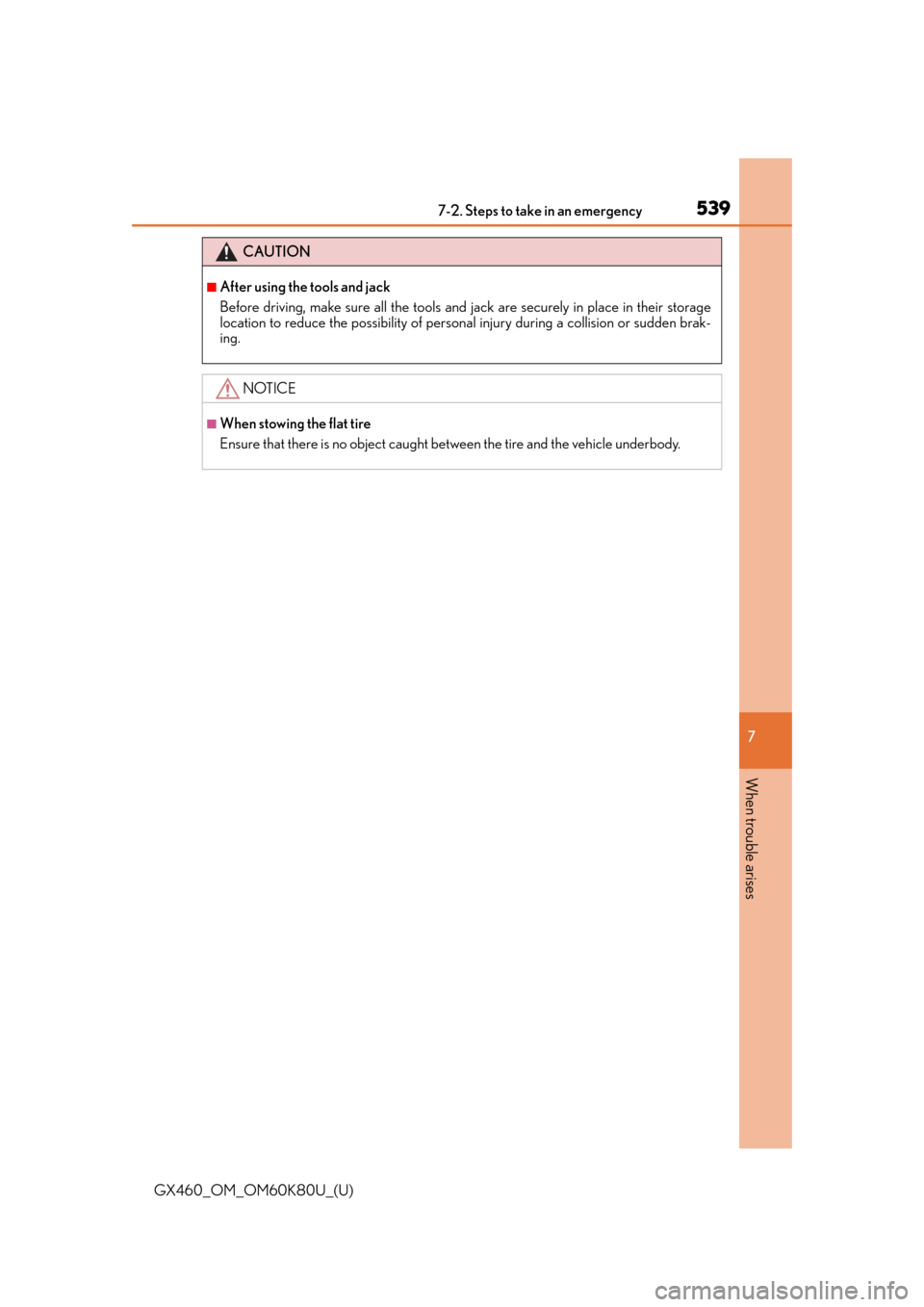
5397-2. Steps to take in an emergency
GX460_OM_OM60K80U_(U)
7
When trouble arises
CAUTION
■After using the tools and jack
Before driving, make sure all the tools and jack are securely in place in their storage
location to reduce the possibility of personal injury during a collision or sudden brak-
ing.
NOTICE
■When stowing the flat tire
Ensure that there is no object caught between the tire and the vehicle underbody.
Page 552 of 622
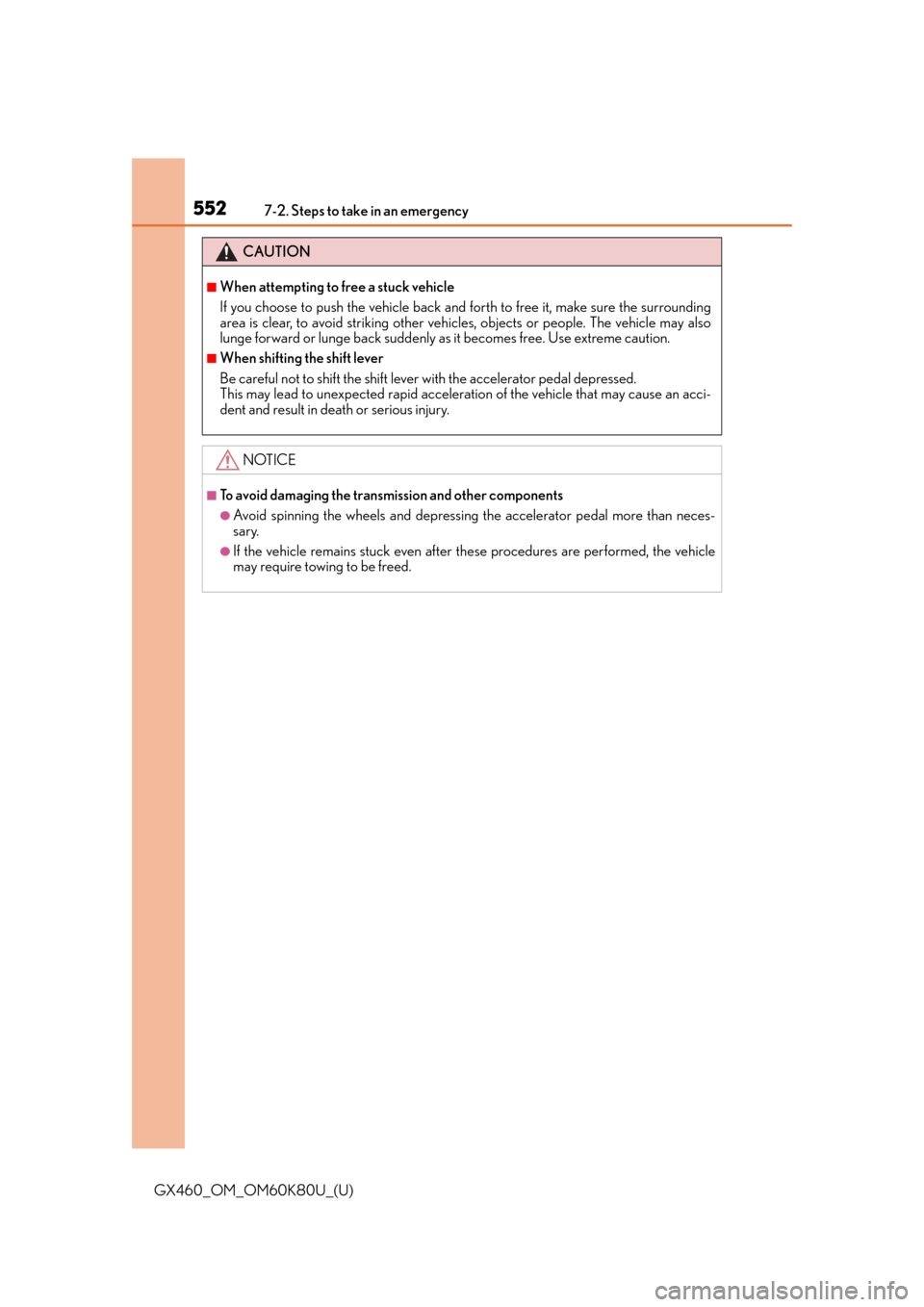
5527-2. Steps to take in an emergency
GX460_OM_OM60K80U_(U)
CAUTION
■When attempting to free a stuck vehicle
If you choose to push the vehicle back and forth to free it, make sure the surrounding
area is clear, to avoid striking other vehicles, objects or people. The vehicle may also
lunge forward or lunge back suddenly as it becomes free. Use extreme caution.
■When shifting the shift lever
Be careful not to shift the shift lever with the accelerator pedal depressed.
This may lead to unexpected rapid acceleration of the vehicle that may cause an acci-
dent and result in death or serious injury.
NOTICE
■To avoid damaging the transmission and other components
●Avoid spinning the wheels and depressing the accelerator pedal more than neces-
sary.
●If the vehicle remains stuck even after th ese procedures are performed, the vehicle
may require towing to be freed.
Page 554 of 622
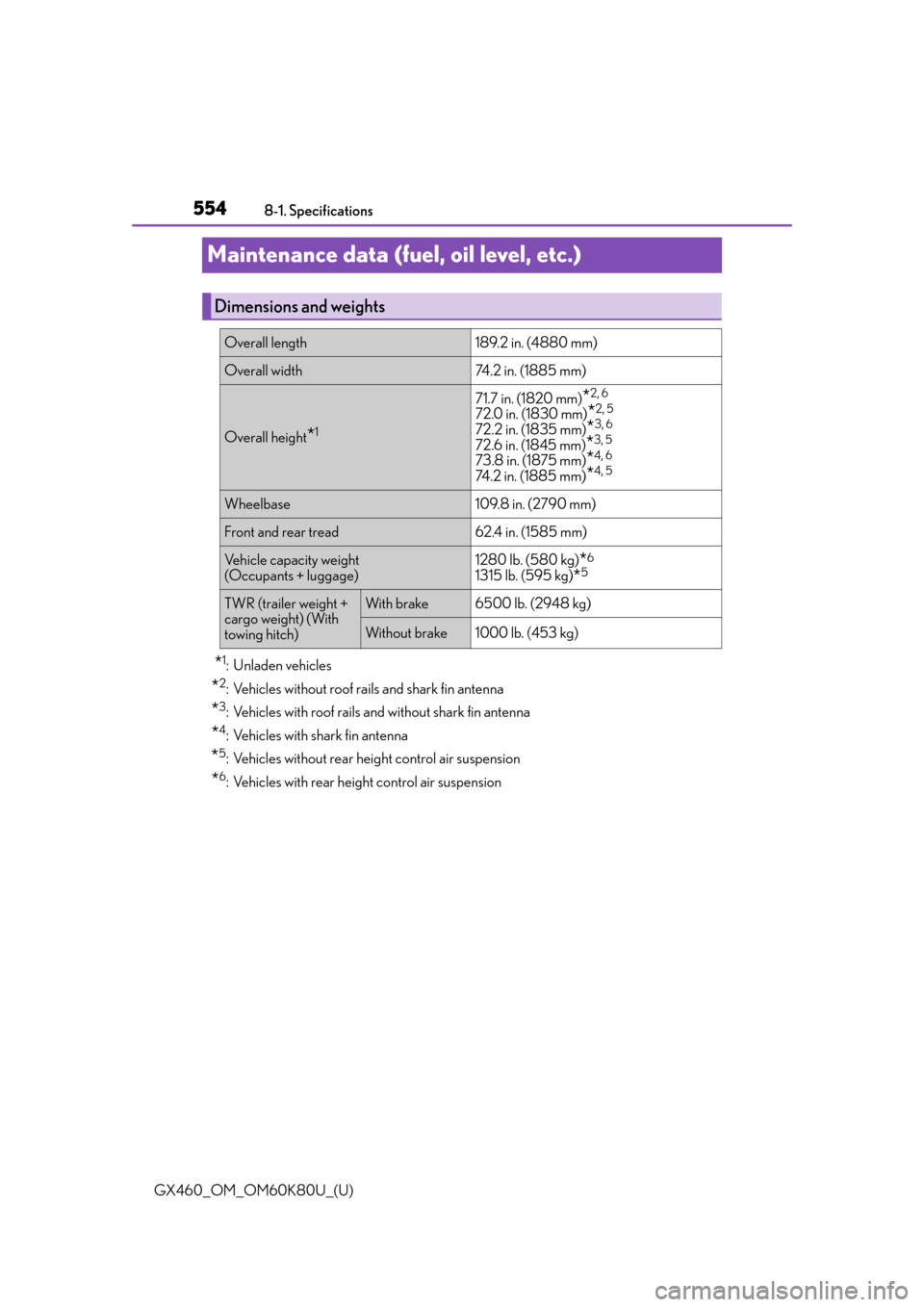
554
GX460_OM_OM60K80U_(U)8-1. Specifications
Maintenance data (fuel, oil level, etc.)
*1: Unladen vehicles
*2: Vehicles without roof ra
ils and shark fin antenna
*3: Vehicles with roof rails and without shark fin antenna
*4: Vehicles with shark fin antenna
*5: Vehicles without rear height control air suspension
*6: Vehicles with rear height control air suspension
Dimensions and weights
Overall length189.2 in. (4880 mm)
Overall width74.2 in. (1885 mm)
Overall height*1
71.7 in. (1820 mm)*2, 6
72.0 in. (1830 mm)*2, 5
72.2 in. (1835 mm)*3, 6
72.6 in. (1845 mm)*3, 5
73.8 in. (1875 mm)*4, 6
74.2 in. (1885 mm)*4, 5
Wheelbase109.8 in. (2790 mm)
Front and rear tread62.4 in. (1585 mm)
Vehicle capacity weight
(Occupants + luggage)1280 lb. (580 kg)*6
1315 lb. (595 kg)*5
TWR (trailer weight +
cargo weight) (With
towing hitch)With brake6500 lb. (2948 kg)
Without brake1000 lb. (453 kg)